Contrary to popular belief, not all dogs are natural swimmers. In fact, many puppies never learn to swim due to the absence of an elder dog.
If you want your dog to swim with you in the pool, you will have to train them yourself.
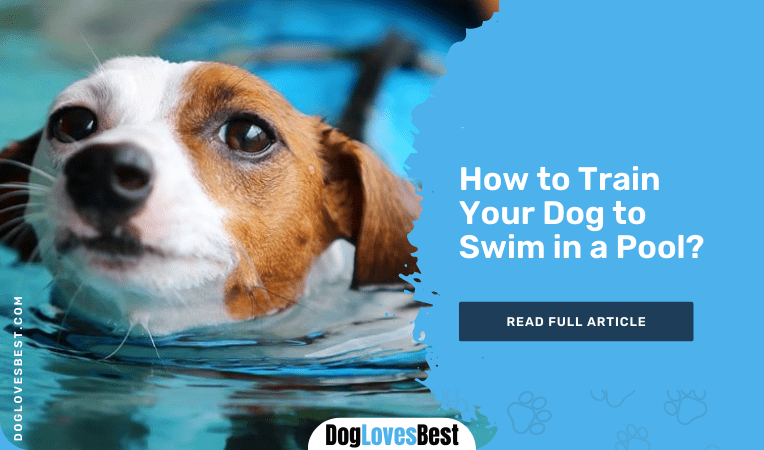
Many pooches have a natural inclination toward the water, however, many don’t. So, be ready to add another task in your dog training manual and start headfirst!
We have curated a detailed guide on how to train your dog to swim in a pool which is going to make the whole process so much easier.
You can also check our list of best pools for dogs this year. Scroll down and learn some of the important basics in less than 10 minutes:
Tips on How to Train Your Dog to Swim in a Pool
While some dogs are naturally suited for swimming, others may not be built to survive in water.
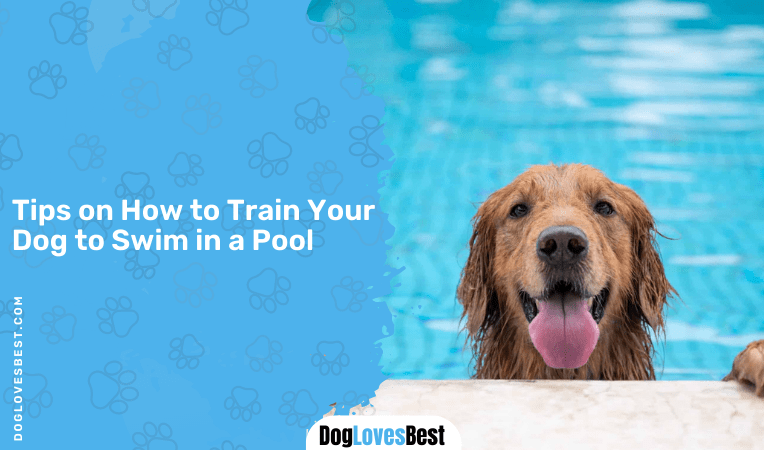
Before you begin to train your dog to swim in the pool with you, you should consider the level of difficulty you will be facing. Some of the safest ways to start this journey are:
Start Slow
The first time you’re teaching your dog how to swim in a pool, you need to make sure it is on a surface with shallow water.
Much like how to train humans, you must not push your dog into deep waters assuming they will ‘wing it’ – not even with the water-friendly pooches.
Walk It
Put a life-jacket on your dog and make them walk on the shallow water. It is important for your pooch to be okay with having water on your body and paws, this is especially crucial if your dog is a reluctant bather in general.
Praise and Treats
When did a dog learn anything from their human without some praise and treats? And anyway, their obedience and patience do deserve some words of praise.
Keep their favorite munchies readily available through the entire training process. Help your canine associate positive emotion with the experience.
Support
Always have your hand palm beneath your dog’s belly during the swim training. Swimming can be a new activity and bodily movement for them, and chances are your pooch will get tired easily in the initial days.
Having your hand support their torso will make learning to swim less taxing. This will also help your pooch use all of their four limbs during the swimming sessions.
Dog’s Comfort
Remember that this is more about them than about you. Your canine’s comfort is of much importance for efficient training, plus – you do not want to cause unnecessary anxiety in your pooch that can forever ruin swimming for them.
Pay attention to their body language and stop the training whenever you sport uneasiness or discomfort.
Post-Training
A post-training ritual can help you associate the experience with a positive one. Here are a couple of tasks you can incorporate after swimming session that can make your dog bond better with you, and remove any anxiety or panic which they may have developed:
- Get Them Out and Use a Ramp
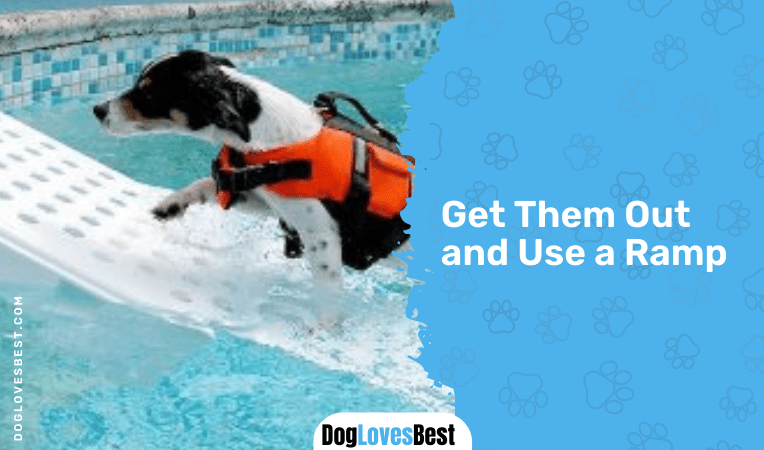
What you do after the swimming training is as important as what happens during it. Make sure to safely help your dog out of the swimming pool. If possible, add on a dog pool ramp and train him or her go in and out through its help. Having your pooch find their own way to and out the pool is an important aspect of the training. With doggie ramps, you can achieve that.
- Rinse, Rinse, Rinse!
Now that you have safely helped your dog out of the swimming pool, make sure to give them the final rinse of fresh water. This helps wash away any algae, dirt, or chemicals that may have stuck to their fur when they were in the water.
- Compliment Their Cooperation
Treats, pats, and verbal praises are key here. Make it known to your pet that you acknowledge their good behavior, patience, and cooperation throughout the training. Make sure to keep some goodies handy every time they exit the pool.
Safety Precautions
You simply cannot go headfirst in training your dog to swim without some important precautions and safety measures to help avoid injury or mental stress to them. Here we have enlisted some of the critical steps to follow when training your dog how to swim in a swimming pool:
Use a Life-jacket
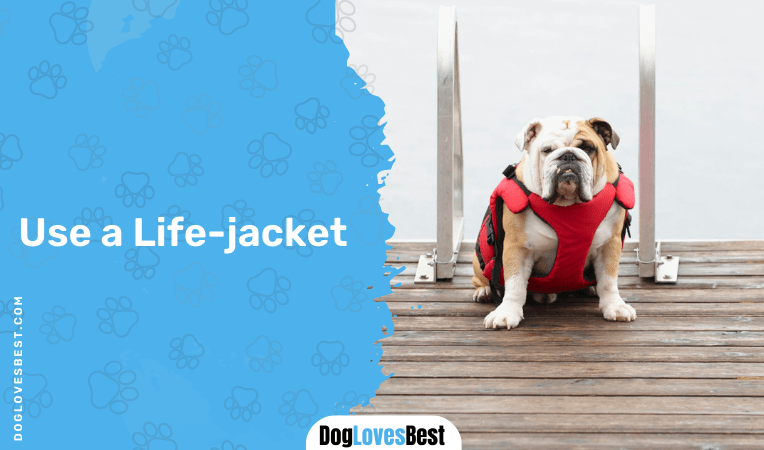
Put a life-jacket on your dog. There are flotation tools available for dogs in the market, one of which is sturdy life-jackets (check our reviews on best puppy life jackets). This is crucial as dogs, especially large dogs, tend to sink to the bottom of the pool the first time they enter the water. Purchase an easy on and off the jacket for your pupper, and make sure it is not only lightweight but also does not restrict their mobility. You can even use dog life vests if you already have it.
Keep Distractions at Bay
It is wise to not train your dog in a public swimming area where there can be a lot of noise, distractions, and – contamination.
In case you have a small pool in your backyard, you should most probably use that. While for small puppies, you can even have a bathtub to your rescue. You can even get a dog pool float to help them.
Fresh Drinking Water
Canines tend to get tired as well as anxious at the beginning of training. The sudden interaction with so much water can be extremely overwhelming for them.
In these cases, it is advisable to have a bowl of fresh drinking water at arms reach. In the absence of drinking water, your dog may resort to guzzling down the pool water.
This can cause a lot of intestinal disturbance, therefore, offering them some freshwater will come across as beneficial.
Keep them on a Leash
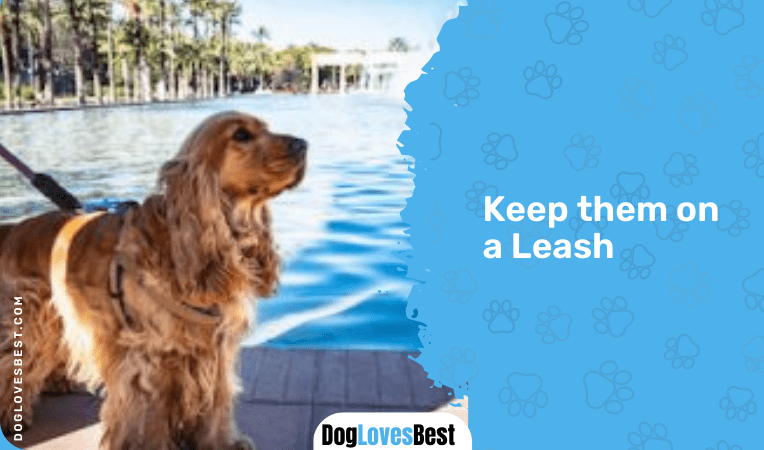
We cannot stress this point enough. You may not be able to have a hold of them at all times. Having a lead on your dog will steer them clear of deep water and other possible threats. Do not remove the lead until you are confident about their swimming skills.
Don’t Force your Dog!
This tactic does not work on anyone. Not humans, not dogs! You want your canine to have positive affiliations with the experience of swimming.
If you force or push your dog into the water, not only will it frighten them, but it may also make them wary of you. This can hurt your bond with your fluffy friend, hence, this is never a good idea.
FAQs
There are several reasons your dog may be afraid of water. Two of the most common reasons are – your dog has had a bad experience around water previously as a child, or they have the fear of unknown.
Either way, it is your job as a pet parent to make sure their comfort is prioritized in the whole training process. Make sure to introduce them to a body of water gradually and carefully.
You may not be the only pet owner with a hydrophobic dog. There are several ways to eradicate this fear of water from your pooch but behold! it takes a lot of patience and energy.
Start by filling shallow waters in tubs or kiddie pools and place your dog inside them. Top them with your dog’s favorite toys and treats to help them associate a body of water with positive experiences.
You can begin training your puppy from the day you bring them home. No, not in a swimming pool. You can fill in your bathtub with shallow water and let your pupper explore around. A proper swim session can be given after the age of two or three months.
Final Note
Training dogs to swim does not have a fix duration. Your puppy may take a few hours to a couple of days into completely accepting swimming as an activity.
Plus, there are many aspects you will need to consider before you have your dog jump in cold pool water on a hot summer day with you.
Keep treats, praises, fresh drinking water, and safety measures in close proximity as your canine explores the new world of swimming.
References
- Hakanen, E. (2020, August 13). Active and social life is associated with lower non-social fearfulness in pet dogs. Nature. https://www.nature.com/articles/s41598-020-70722-7
- Amodeo, K. (2022, June 22). 8 summer safety tips for keeping your dog cool. UGA Today. https://news.uga.edu/dog-days-of-summer-uga-vets-safety-tips/
- (2020b, November 3). Protect Your Dog From Harmful Algal Blooms. Utah Department of Environmental Quality. https://deq.utah.gov/water-quality/protect-your-dog-from-harmful-algal-blooms

James Wilkinson joined DogLovesBest as a full-time writer with the objective of offering his insights on how to rear pets better. He shares the information through the experience he has gained over a span of 15 years working as a dog trainer. James also used to contribute regularly to several pet publications during his career as a trainer before joining this website. He also donates a portion of his own personal wealth to shelter abandoned animals in Gainesville, Florida and helps in finding a new home for them.
